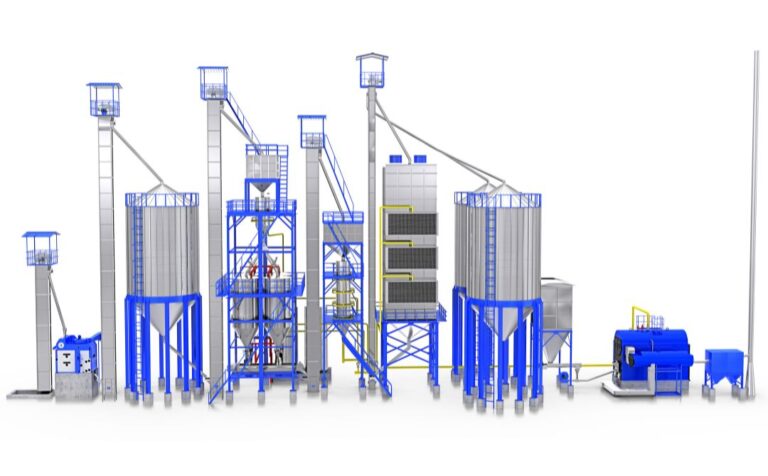Table of Contents
In India, where rice is a staple food and a cornerstone of agricultural livelihoods, the efficiency of post-harvest processing directly impacts farmers’ incomes and food security. With over 120 million tonnes of paddy produced annually, proper drying is essential to preserve grain quality and minimize losses. Inefficient drying can lead to spoilage, reduced yields, and lower market value.
At SKF Elixer, we empower farmers and millers with advanced paddy dryer plants, engineered to deliver high-efficiency grain drying tailored for India’s diverse agricultural landscape. Our cutting-edge dryer technology ensures optimal moisture control, maximizing profitability and sustainability.
This blog explores how paddy dryer plants enhance grain drying efficiency, the technology behind them, and why SKF Elixer’s solutions are ideal for Indian rice processors. Whether you’re a farmer in Punjab, a cooperative leader in Andhra Pradesh, or a mill owner in West Bengal, our insights will guide you toward smarter drying practices.
The Importance of Efficient Grain Drying
Paddy drying is a critical step in rice production, reducing moisture content from 18–24% to 12–14% to prevent fungal growth, insect infestation, and grain breakage during milling. Inefficient drying, such as traditional sun-drying, can result in losses of 5–10%, equating to 500–1,000 kilograms per 10 tonnes of paddy, worth ₹25,000–₹50,000 at market rates of ₹50 per kilogram.
Uneven drying also lowers head rice recovery by 4–8%, reducing market value by ₹5–10 per kilogram. For a medium-sized mill processing 50 tonnes daily, this translates to annual losses of ₹50 lakh–₹1 crore.
Modern paddy dryer plants, like those from SKF Elixer, use advanced dryer technology to achieve uniform grain drying, reducing losses to below 2% and boosting head rice recovery to 95–97%. These systems align with India’s ₹5 lakh crore rice industry and Food Safety and Standards Authority of India (FSSAI) quality standards, ensuring higher profits and sustainability.
How Paddy Dryer Plants Work
Paddy dryer plants employ a systematic process to optimize grain drying efficiency:
1. Pre-Cleaning
Paddy is screened to remove debris (1–2 kilograms per tonne), such as stones and husk, preventing blockages and ensuring uniform airflow. For a 5-tonne batch, this saves ₹5,000–₹10,000 in potential grain loss due to contamination.
2. Heat Generation
Dryers use heat sources like biomass or paddy husk to generate hot air (40–50°C). Energy-efficient systems consume 50–80 kilograms of husk per tonne, costing ₹500–₹800 at ₹10 per kilogram, saving ₹1–1.5 lakh annually for a 10-tonne-per-hour plant compared to diesel-based systems.
3. Uniform Air Circulation
High-efficiency blowers (5,000–8,000 m³/hour) distribute hot air evenly through drying chambers, reducing drying time to 6–8 hours per batch. This prevents grain cracking, ensuring 95–97% head rice recovery and saving 100–200 kilograms per 5-tonne batch, worth ₹5,000–₹10,000.
4. Moisture Control
IoT-enabled sensors monitor grain moisture in real time, maintaining 12–14% levels. For a 10-tonne batch, this removes 400–600 kilograms of water, preventing spoilage and saving ₹20,000–₹30,000 per batch in losses.
5. Cooling and Discharge
Post-drying, grains are cooled to 25–30°C to prevent thermal stress, preserving milling quality. This saves 50–100 kilograms per batch, worth ₹2,500–₹5,000, for a 5-tonne dryer.
Benefits of Using a Paddy Dryer Plant
SKF Elixer’s paddy dryer plants offer significant advantages:
- Enhanced Grain Quality: Uniform drying ensures 95–97% head rice recovery, increasing market value by ₹5–10 per kilogram, adding ₹25 lakh–₹50 lakh annually for a 50-tonne-per-day mill.
- Reduced Losses: Lowers spoilage and breakage to below 2%, saving ₹50,000–₹1 lakh daily for a 20-tonne-per-day operation.
- Energy Efficiency: Consumes 30–40% less fuel than traditional dryers, saving ₹1–2 lakh annually for a 10-tonne-per-hour plant.
- Sustainability: Biomass-based systems reduce waste by 20%, generating ₹2–3 lakh annually from surplus husk sales, aligning with India’s National Biofuel Policy.
Energy-Efficient Paddy Drying Technology
SKF Elixer’s dryers incorporate energy-efficient features:
- Biomass Utilization: Use paddy husk or agricultural residues, reducing fuel costs by ₹1–2 lakh annually for a 5-tonne-per-hour plant.
- Optimized Airflow: High-efficiency blowers reduce drying time by 20%, saving ₹50,000–₹1 lakh annually in energy costs.
- Smart Controls: Sensors adjust heat and airflow, cutting energy use by 15–20%, saving ₹30,000–₹50,000 annually for a 10-tonne-per-hour dryer.
Modern Methods of Paddy Grain Drying
Modern drying methods, like SKF Elixer’s commercial drying systems, surpass traditional sun-drying:
- Consistency: Achieve uniform moisture levels (12–14%), unlike sun-drying’s 5–10% variation, saving ₹25,000–₹50,000 per 10 tonnes.
- Speed: Dry 5 tonnes in 6–8 hours versus 2–3 days for sun-drying, increasing throughput by 50% for mills.
- Weather Independence: Operate year-round, avoiding monsoon-related losses of ₹50,000–₹1 lakh per season.
Why Choose SKF Elixer?
With years of expertise, SKF Elixer delivers BIS-certified paddy dryer plants tailored for India’s humid and arid climates. Our options, support, and Annual Maintenance Contracts (AMCs) ensure reliability and affordability for millers across India.
Conclusion
Paddy dryer plants are transforming grain drying efficiency, reducing losses, and enhancing rice quality for India’s ₹5 lakh crore rice industry. SKF Elixer’s advanced dryer technology, with energy-efficient and smart features, empowers farmers and millers to maximize profitability and sustainability. Choose our solutions to elevate your rice processing operations.
Ready to boost your grain drying efficiency? Contact SKF Elixer to explore our tailored paddy dryer plants.
FAQs
-
1. How do paddy dryer plants improve grain drying efficiency?
Paddy dryer plants use uniform airflow and smart moisture control to reduce drying time to 6–8 hours per batch, achieving 95–97% head rice recovery and saving ₹50,000–₹1 lakh daily in losses for a 20-tonne-per-day mill.
-
2. What are the best paddy dryer machines for farmers?
2–5-tonne-per-hour dryers use biomass for energy efficiency, saving ₹1–2 lakh annually in fuel and losses, ideal for small-scale farmers in Andhra Pradesh or Odisha.
-
3. What are the benefits of using a paddy dryer plant?
They ensure 95–97% head rice recovery (₹5–10 more per kg), reduce losses to below 2% (₹50,000–₹1 lakh daily savings), and save 30–40% on fuel (₹1–2 lakh annually for 10 tonnes/hour), enhancing profitability.
-
4. How does energy-efficient paddy drying technology work?
SKF Elixer’s dryers use biomass (50–80 kg per tonne, ₹500–₹800) and sensors to optimize airflow, cutting energy use by 15–20% and saving ₹50,000–₹1 lakh annually for a 10-tonne-per-hour plant.
-
5. What are modern methods of paddy grain drying?
Modern methods use automated dryers with uniform heat (40–50°C) and smart controls, drying 5 tonnes in 6–8 hours versus 2–3 days for sun-drying, saving ₹25,000–₹50,000 per 10 tonnes and ensuring consistent quality.
Good reads are meant to be shared









